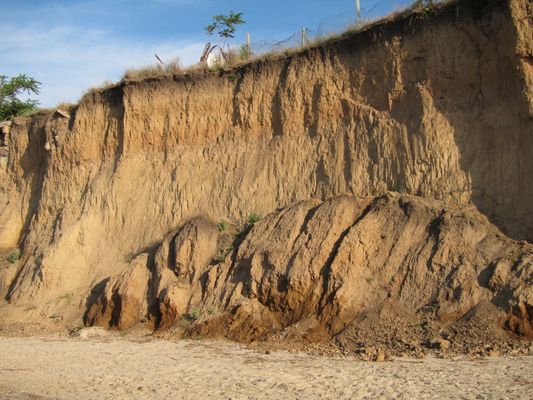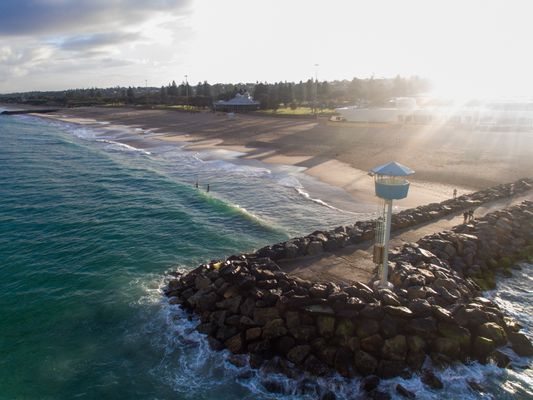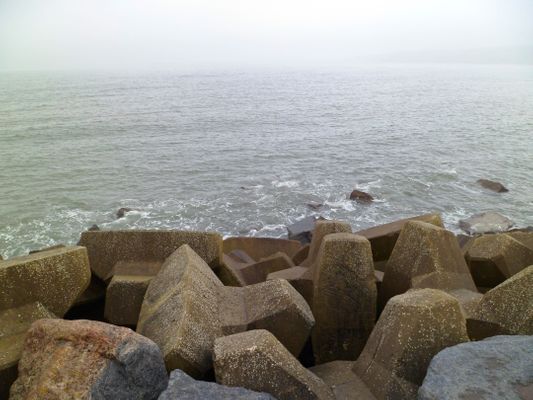Coastal Management Case Study - Holderness
Coastal erosion in holderness.
The Holderness coast is located next to the city of Hull in the north-east of England. Each year, the Holderness Coast retreats 1-2 metres. The area is particularly vulnerable to erosion because of:


Strong prevailing winds
- Strong prevailing winds create destructive waves that can do more damage to the coast.
- The prevailing winds also mean that any eroded material moves away from the place that was eroded (leaving the soft rock exposed).

Clay cliffs
- The Holderness Coast is made of boulder clay.
- This is very soft and easy to erode.
- Heavy rainfall can cause mass movements in the boulder clay cliffs.
Coastal Management in Holderness
In 1991, a £2 million project built rock groynes and rock revetments at Mappleton in the Holderness coast. These are examples of hard engineering.

Rock groynes
- The rock groynes tried to stop sediment being carried away from the Holderness Coast and tried to create a larger beach to protect the land behind.

Rock armour
- Rock armour was placed at the foot of the cliffs.
- The rock armour is meant to absorb some of the waves' energy, instead of the coast or cliffs.
What are the Results & Effects of Coastal Management at Mappleton?
The cliffs at Mappleton now erode at 1-2 metres per year, instead of the 7-10 metres before 1991. Mappleton now has a larger beach, however, there have been some negative effects:

Area south of Mappleton
- The area south of Mappleton is experiencing faster coastal erosion as a byproduct.

Spurn Point
- The Spurn Point area south, has become less secure.
- Less material is washed down the Holderness Coast.
- Some Hebridean Sheep were washed away and killed. People are now warned not to visit the Point at some times of year, or they too could be washed away.

Spurn Point lifeboat & visitor's centre
- £471,000 was spent on a visitor's centre which could become less accessible over time.
- Lifeboat services also operate from Spurn Point.
1 The Challenge of Natural Hazards
1.1 Natural Hazards
1.1.1 Natural Hazards
1.1.2 Types of Natural Hazards
1.1.3 Factors Affecting Risk
1.1.4 People Affecting Risk
1.1.5 Ability to Cope With Natural Hazards
1.1.6 How Serious Are Natural Hazards?
1.1.7 End of Topic Test - Natural Hazards
1.1.8 Exam-Style Questions - Natural Hazards
1.2 Tectonic Hazards
1.2.1 The Earth's Layers
1.2.2 Tectonic Plates
1.2.3 The Earth's Tectonic Plates
1.2.4 Convection Currents
1.2.5 Plate Margins
1.2.6 Volcanoes
1.2.7 Volcano Eruptions
1.2.8 Effects of Volcanoes
1.2.9 Primary Effects of Volcanoes
1.2.10 Secondary Effects of Volcanoes
1.2.11 Responses to Volcanic Eruptions
1.2.12 Immediate Responses to Volcanoes
1.2.13 Long-Term Responses to Volcanoes
1.2.14 Earthquakes
1.2.15 Earthquakes at Different Plate Margins
1.2.16 What is an Earthquake?
1.2.17 Measuring Earthquakes
1.2.18 Immediate Responses to Earthquakes
1.2.19 Long-Term Responses to Earthquakes
1.2.20 Case Studies: The L'Aquila Earthquake
1.2.21 Case Studies: The Kashmir Earthquake
1.2.22 Earthquake Case Study: Chile 2010
1.2.23 Earthquake Case Study: Nepal 2015
1.2.24 Reducing the Impact of Tectonic Hazards
1.2.25 Protecting & Planning
1.2.26 Living with Tectonic Hazards 2
1.2.27 End of Topic Test - Tectonic Hazards
1.2.28 Exam-Style Questions - Tectonic Hazards
1.2.29 Tectonic Hazards - Statistical Skills
1.3 Weather Hazards
1.3.1 Winds & Pressure
1.3.2 The Global Atmospheric Circulation Model
1.3.3 Surface Winds
1.3.4 UK Weather Hazards
1.3.5 Changing Weather in the UK
1.3.6 Tropical Storms
1.3.7 Tropical Storm Causes
1.3.8 Features of Tropical Storms
1.3.9 The Structure of Tropical Storms
1.3.10 The Effect of Climate Change on Tropical Storms
1.3.11 The Effects of Tropical Storms
1.3.12 Responses to Tropical Storms
1.3.13 Reducing the Effects of Tropical Storms
1.3.14 Tropical Storms Case Study: Katrina
1.3.15 Tropical Storms Case Study: Haiyan
1.3.16 UK Weather Hazards Case Study: Somerset 2014
1.3.17 End of Topic Test - Weather Hazards
1.3.18 Exam-Style Questions - Weather Hazards
1.3.19 Weather Hazards - Statistical Skills
1.4 Climate Change
1.4.1 Climate Change
1.4.2 Evidence for Climate Change
1.4.3 Natural Causes of Climate Change
1.4.4 Human Causes of Climate Change
1.4.5 Effects of Climate Change on the Environment
1.4.6 Effects of Climate Change on People
1.4.7 Climate Change Mitigation Strategies
1.4.8 Adaptation to Climate Change
1.4.9 End of Topic Test - Climate Change
1.4.10 Exam-Style Questions - Climate Change
1.4.11 Climate Change - Statistical Skills
2 The Living World
2.1 Ecosystems
2.1.1 Ecosystems
2.1.2 Food Chains & Webs
2.1.3 Ecosystem Cascades
2.1.4 Global Ecosystems
2.1.5 Ecosystem Case Study: Freshwater Ponds
2.2 Tropical Rainforests
2.2.1 Tropical Rainforests
2.2.2 Interdependence of Tropical Rainforests
2.2.3 Adaptations of Plants to Rainforests
2.2.4 Adaptations of Animals to Rainforests
2.2.5 Biodiversity of Tropical Rainforests
2.2.6 Deforestation
2.2.7 Impacts of Deforestation
2.2.8 Case Study: Deforestation in the Amazon Rainforest
2.2.9 Why Protect Rainforests?
2.2.10 Sustainable Management of Rainforests
2.2.11 Case Study: Malaysian Rainforest
2.2.12 End of Topic Test - Tropical Rainforests
2.2.13 Exam-Style Questions - Tropical Rainforests
2.2.14 Deforestation - Statistical Skills
2.3 Hot Deserts
2.3.1 Hot Deserts
2.3.2 Interdependence in Hot Deserts
2.3.3 Adaptation of Plants to Hot Deserts
2.3.4 Adaptation of Animals to Hot Deserts
2.3.5 Biodiversity in Hot Deserts
2.3.6 Case Study: Sahara Desert
2.3.7 Desertification
2.3.8 Reducing the Risk of Desertification
2.3.9 Case Study: Thar Desert
2.3.10 End of Topic Test - Hot Deserts
2.3.11 Exam-Style Questions - Hot Deserts
2.4 Tundra & Polar Environments
2.4.1 Overview of Cold Environments
2.4.2 Interdependence of Cold Environments
2.4.3 Adaptations of Plants to Cold Environments
2.4.4 Adaptations of Animals to Cold Environments
2.4.5 Biodiversity in Cold Environments
2.4.6 Case Study: Alaska
2.4.7 Sustainable Management
2.4.8 Case Study: Svalbard
2.4.9 End of Topic Test - Tundra & Polar Environments
2.4.10 Exam-Style Questions - Cold Environments
3 Physical Landscapes in the UK
3.1 The UK Physical Landscape
3.1.1 The UK Physical Landscape
3.1.2 Examples of the UK's Landscape
3.2 Coastal Landscapes in the UK
3.2.1 Types of Wave
3.2.2 Weathering
3.2.3 Mass Movement
3.2.4 Processes of Erosion
3.2.5 Wave-Cut Platforms
3.2.6 Headlands & Bays
3.2.7 Caves, Arches & Stacks
3.2.8 Longshore Drift
3.2.9 Sediment Transport
3.2.10 Deposition
3.2.11 Spits, Bars & Sand Dunes
3.2.12 Coastal Management - Hard Engineering
3.2.13 Coastal Management - Soft Engineering
3.2.14 Case Study: Landforms on the Dorset Coast
3.2.15 Coastal Management - Managed Retreat
3.2.16 Coastal Management Case Study - Holderness
3.2.17 Coastal Management Case Study: Swanage
3.2.18 Coastal Management Case Study - Lyme Regis
3.2.19 End of Topic Test - Coastal Landscapes in the UK
3.2.20 Exam-Style Questions - Coasts
3.3 River Landscapes in the UK
3.3.1 The Long Profile of a River
3.3.2 The Cross Profile of a River
3.3.3 Vertical & Lateral Erosion
3.3.4 River Valley Case Study - River Tees
3.3.5 Processes of Erosion
3.3.6 Sediment Transport
3.3.7 River Deposition
3.3.8 Waterfalls & Gorges
3.3.9 Interlocking Spurs
3.3.10 Meanders
3.3.11 Oxbow Lakes
3.3.12 Floodplains
3.3.13 Levees
3.3.14 Estuaries
3.3.15 Case Study: The River Clyde
3.3.16 River Management
3.3.17 Hydrographs
3.3.18 Flood Defences - Hard Engineering
3.3.19 Flood Defences - Soft Engineering
3.3.20 River Management Case Study - Boscastle
3.3.21 River Management Case Study - Banbury
3.3.22 End of Topic Test - River Landscapes in the UK
3.3.23 Exam-Style Questions - Rivers
3.4 Glacial Landscapes in the UK
3.4.1 The UK in the Last Ice Age
3.4.2 Glacial Processes
3.4.3 Glacial Landforms Caused by Erosion
3.4.4 Tarns, Corries, Glacial Troughs & Truncated Spurs
3.4.5 Types of Moraine
3.4.6 Drumlins & Erratics
3.4.7 Snowdonia
3.4.8 Land Use in Glaciated Areas
3.4.9 Conflicts in Glacial Landscapes
3.4.10 Tourism in Glacial Landscapes
3.4.11 Coping with Tourism Impacts in Glacial Landscapes
3.4.12 Case Study - Lake District
3.4.13 End of Topic Test - Glacial Landscapes in the UK
3.4.14 Exam-Style Questions - Glacial Landscapes
4 Urban Issues & Challenges
4.1 Urban Issues & Challenges
4.1.1 Urbanisation
4.1.2 Factors Causing Urbanisation
4.1.3 Megacities
4.1.4 Urbanisation Case Study: Lagos
4.1.5 Urbanisation Case Study: Rio de Janeiro
4.1.6 UK Cities
4.1.7 Case Study: Urban Regen Projects - Manchester
4.1.8 Case Study: Urban Change in Liverpool
4.1.9 Case Study: Urban Change in Bristol
4.1.10 Sustainable Urban Life
4.1.11 Reducing Traffic Congestion
4.1.12 End of Topic Test - Urban Issues & Challenges
4.1.13 Exam-Style Questions - Urban Issues & Challenges
4.1.14 Urban Issues -Statistical Skills
5 The Changing Economic World
5.1 The Changing Economic World
5.1.1 Measuring Development
5.1.2 Limitations of Developing Measures
5.1.3 Classifying Countries Based on Wealth
5.1.4 The Demographic Transition Model
5.1.5 Stages of the Demographic Transition Model
5.1.6 Physical Causes of Uneven Development
5.1.7 Historical Causes of Uneven Development
5.1.8 Economic Causes of Uneven Development
5.1.9 Consequences of Uneven Development
5.1.10 How Can We Reduce the Global Development Gap?
5.1.11 Case Study: Tourism in Kenya
5.1.12 Case Study: Tourism in Jamaica
5.1.13 Case Study: Economic Development in India
5.1.14 Case Study: Aid & Development in India
5.1.15 Case Study: Economic Development in Nigeria
5.1.16 Case Study: Aid & Development in Nigeria
5.1.17 End of Topic Test - The Changing Economic World
5.1.18 Exam-Style Questions - The Changing Economic World
5.1.19 Changing Economic World - Statistical Skills
5.2 Economic Development in the UK
5.2.1 Causes of Economic Change in the UK
5.2.2 The UK's Post-Industrial Economy
5.2.3 The Impacts of UK Industry on the Environment
5.2.4 Change in the UK's Rural Areas
5.2.5 Transport in the UK
5.2.6 The North-South Divide
5.2.7 Regional Differences in the UK
5.2.8 The UK's Links to the World
6 The Challenge of Resource Management
6.1 Resource Management
6.1.1 Global Distribution of Resources
6.1.2 Uneven Distribution of Resources
6.1.3 Food in the UK
6.1.4 Agribusiness
6.1.5 Demand for Water in the UK
6.1.6 Water Pollution in the UK
6.1.7 Matching Supply & Demand of Water in the UK
6.1.8 The UK's Energy Mix
6.1.9 Issues with Sources of Energy
6.1.10 Resource Management - Statistical Skills
6.2.1 Areas of Food Surplus & Food Deficit
6.2.2 Increasing Food Consumption
6.2.3 Food Supply & Food Insecurity
6.2.4 Impacts of Food Insecurity
6.2.5 Increasing Food Supply
6.2.6 Case Study: Thanet Earth
6.2.7 Creating a Sustainable Food Supply
6.2.8 Case Study: Agroforestry in Mali
6.2.9 End of Topic Test - Food
6.2.10 Exam-Style Questions - Food
6.2.11 Food - Statistical Skills
6.3.1 Water Surplus & Water Deficit
6.3.2 Increasing Water Consumption
6.3.3 What Affects the Availability of Water?
6.3.4 Impacts of Water Insecurity
6.3.5 Increasing Water Supplies
6.3.6 Case Study: Water Transfer in China
6.3.7 Sustainable Water Supply
6.3.8 Case Study: Kenya's Sand Dams
6.3.9 Case Study: Lesotho Highland Water Project
6.3.10 Case Study: Wakel River Basin Project
6.3.11 Exam-Style Questions - Water
6.3.12 Water - Statistical Skills
6.4.1 Global Demand for Energy
6.4.2 Increasing Energy Consumption
6.4.3 Factors Affecting Energy Supply
6.4.4 Impacts of Energy Insecurity
6.4.5 Increasing Energy Supply - Solar
6.4.6 Increasing Energy Supply - Water
6.4.7 Increasing Energy Supply - Wind
6.4.8 Increasing Energy Supply - Nuclear
6.4.9 Increasing Energy Supply - Fossil Fuels
6.4.10 Carbon Footprints
6.4.11 Energy Conservation
6.4.12 Case Study: Rice Husks in Bihar
6.4.13 Exam-Style Questions - Energy
6.4.14 Energy - Statistical Skills
Jump to other topics

Unlock your full potential with GoStudent tutoring
Affordable 1:1 tutoring from the comfort of your home
Tutors are matched to your specific learning needs
30+ school subjects covered
Coastal Management - Managed Retreat
Coastal Management Case Study: Swanage

- Search Events & CPD
- GA Annual Conference and Exhibition
- GA CPD courses
- Consultancy services
- Quality Marks
- CPD Toolkit
- GA Subject Knowledge Scholar Programme
- Study Tours
- Geography Education Research

Online Teaching Resources
- Geography subject leadership
- Curriculum planning
- Progression and assessment in geography
- Classroom practice
- Geography fieldwork
- Promoting geography
- Become a geography teacher
- Support for geography teacher educators
- Support for primary geography teacher educators
- Support for trainees and ECTs
- Learning to teach secondary geography
- Networking Calendar
- GA Branches
- Student Activities
Support the GA
- Volunteer Groups
- Write for the GA
- Coastal processes and landforms of North Norfolk

This resource, written by Andy Owen, is one of a range of resources which the GA has developed in partnership with the Environment Agency. It provides support for GCSE geography students and focuses on coastal processes and landforms of the North Norfolk coast.
The resource has been created to support student knowledge and understanding of:
- coastal processes including mass movement, erosion, transportation and deposition
- distinctive coastal landforms that are the result of rock type, structure and physical processes including cliffs, wave-cut platforms, beaches and sand dunes
- an example of a section of coastline in the UK to identify its major landforms of erosion and deposition – using a case study of the North Norfolk coast
- the costs and benefits of coastal management strategies, including hard engineering, soft engineering and managed retreat
- an example of a coastal management scheme in the UK – using a case study of Overstrand, Norfolk.
The resource also reinforces a number of geographical skills including:
- ascribing meaning to interpret evidence in photographs
- the annotation of photographs
- decision making.
Download : Resources (ZIP file)

Your Resources
Save this resource to your Dashboard
View any Online Teaching Resources you have saved
Geography Quality Marks
The GA’s Geography Quality Marks reward and promote high quality geography in primary and secondary schools.
Our Shop offers a variety of products from handbooks to globes, posters to toolkits, and much more.
Want to access all our Online Teaching Resources?
Many of our Online Teaching Resources are only available for GA members.
Find out information about our different types of memberships and join the GA today to view hundreds of resources on a wide variety of topics
We have much more support and guidance available including a wide range of events, publications, teaching resources and ways of getting involved with the GA that you also might be interested in.
More from GA
Explore our wide range support from the ga.

Events & CPD

Get connected

Curriculum support
Keep in touch.
Sign up to the GA’s newsletter for the latest ideas, support and advice in geography education. Log in, or create an account, and sign up for our newsletter.

© The Geographical Association 2024
Charity No: 1135148 Company No: 07139068

Strategic Partners


IMAGES